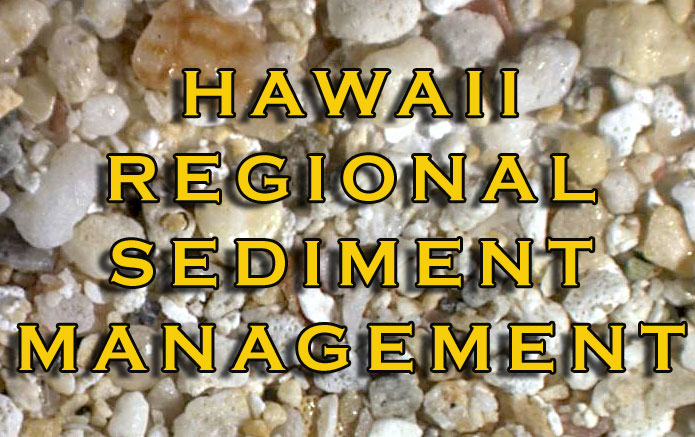A preliminary Diamond Head to Pearl Harbor (D2P) Regional Sediment Budget has been created. The budget was authored in December 2009 by Moffatt & Nichol, the U.S. Army Corps of Engineers - Honolulu District, and the State of Hawai'i Department of Land & Natural Resources. You can download the budget in its entirety by clicking on the link below.
>>Diamond Head to Pearl Harbor Preliminary Regional Sediment Budget
The preliminary sediment budget summarizes existing knowledge of the sediment transport regime in the Diamond Head to Pearl Harbor (D2P) study area, along the south shore of O‘ahu. The information used to develop the preliminary sediment budget includes the following:
• Beach and near-shore profiles published in a variety of sources;
• Dredging records and other publicly available documents describing sediment sources and sinks;
• Shoreline change analyses performed by the University of Hawai‘i and extended in minor ways by Moffatt & Nichol;
• Recent wave and current modeling performed by the U.S. Army Corps of Engineers.
The sediment budget divides the D2P study area into six littoral cells. For all cells, the transport rates are small - generally less than 2,000 cubic yards per year. For some of the cells, particularly the Iroquois Point cell on the ‘Ewa side of Pearl Harbor, there may be a significant input of sediment from ongoing reef production. It is not known whether modern sand production by reefs is actually significant in the D2P study area – this is an important data gap, which can be filled through radiocarbon dating of beach sand.
Results for the six littoral cells include the following:
• Diamond Head is a slightly erosional cell. Transport rates in this cell are small – a few hundreds of cubic yards annually. There may be a small modern production of sand by the near-shore reef: this sand would be transported north into the Waikiki cell or offshore into deep water.
• The heavily engineered Waikiki cell is generally erosional at present, with sand moving from the beaches to the reef and further offshore. Between 1965 and 1985, beach nourishment at an average rate of approximately 10,000 cubic yards annually led to an accretion of the beach along the central and ‘Ewa portions of the Waikiki cell. However, this reversed between 1985 and 2005, when almost no beach nourishment took place. The 2006 nourishment at Kuhio Beach, if it is not an isolated event, may halt the ongoing erosion.
• The Ala Moana cell is similar in behavior to Waikiki. The beach at Magic Island is protected by three detached breakwaters, and is generally stable. The beach at Ala Moana Park is losing sand at a rate of about 1,000 cubic yards per year. While 30,000 cubic yards of sand was placed in 1976, this has since been lost offshore.
• The Sand Island cell contains little sand. Transport rates are low – a few hundreds of cubic yards annually.
• Similarly, the Reef Runway cell is almost entirely sand-starved. It is dominated by the Honolulu Reef Runway, which was constructed over the near-shore reef. Deep dredged channels at either side of the cell, and rip currents that are able to transport sand offshore, act as sinks for any sand that may be produced by the near-shore reef.
• The Iroquois Point cell, ‘Ewa of Pearl Harbor, contains a combination of erosional and accretional areas. Most of the south-facing shoreline of this cell, along ‘Ewa Beach, is slightly accretional. This may result from reef production or long-shore sand transport from the ‘Ewa side. Keahi Point is extremely erosional, likely because of loss into the dredged channel at Pearl Harbor: some of the 3,800 cubic yards lost annually from this part of the littoral cell is transported to the beach within Pearl Harbor, just south of Iroquois Lagoon.
The following investigations would reduce uncertainties associated with the preliminary regional sediment budget developed in this report.
• A regular program of aerial photography should be planned to allow ongoing erosion hazard mapping and monitoring of the sediment budget. A new flight every 5 years is recommended, with additional flights around significant events such as beach nourishment or other shoreline infrastructure, hurricanes, or tsunami. In particular, the effects of the 2006 nourishment of Kuhio Beach do not yet appear to have been captured through aerial photography.
• In the area from Diamond Head to Ala Moana, there appears to be significant movement of sand between the beaches and the reef. This sediment circulation is not well understood. Given the likely need for ongoing nourishment at Waikiki Beach, this should be investigated further through field work – including ongoing beach and near-shore profiling, wave/current measurements, and more detailed investigations of sand pockets on the reef – as well as through more detailed modeling analyses.
• The sand on the beach at Waikiki is largely imported from other areas. For the remainder of the D2P region, the sand was originally produced from the fringing reef system. It is not known whether modern production of sand is a significant contributor to the sediment budget in the area. This should be investigated, in the first instance through radiocarbon dating of beach sand.
• Sand sampling should be performed within Pearl Harbor and Honolulu Harbor, to determine the quality and volume of potential sand sources and to progress the present state of knowledge regarding sediment transport pathways.
• If significant sand from offshore sources is found in one or both of these harbors, the sediment transport pathways should be investigated further through field work – including wave and current data collection and possibly turbidity / sediment concentration measurements – and through more detailed modeling analyses.
Finally, the potential effects of climate change on the study area have not been addressed in the present RSM Plan. This should be incorporated into the planning process. Sea level rise, the potential effects of ocean acidification and reef degradation on sediment availability, and the potential for changes to the wave climate should all be considered.



